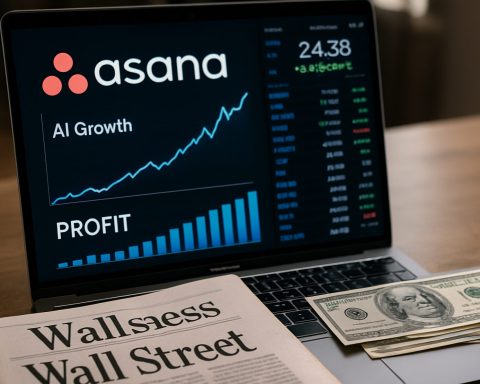- Weibo serves as a reminder that not every tech stock becomes a multi-bagger.
- Key metrics for potential success include a growing Return on Capital Employed (ROCE) and expanding capital base.
- Weibo’s ROCE fell from a five-year peak of 15% to 8.9%, close to the industry average of 7.8%.
- Investors have witnessed a sharp stock value decline of 73% over five years.
- Despite increased investments for growth, expected surges in sales are lacking.
- Potential misalignment exists between strategy and execution, with capital inputs not yielding anticipated benefits.
- Careful financial navigation is crucial in the volatile interactive media industry.
- Diligent investors are advised to employ cautious strategies, remain vigilant, and consider diversification.
- Weibo illustrates that not all large companies promise stability, advocating for a balanced approach to risk.
The vast digital landscape often shimmers with the promise of exponential returns, but sometimes, hidden beneath glossy headlines and alluring prospects, deeper truths lurk. Weibo, a giant in the interactive media sphere, stands as a case study of hope meeting stark financial reality. While the concept of a multi-bagger—a stock yielding multiple times the initial investment—seems alluring, not every player in the tech arena wears this crown.
The allure starts with two fundamental metrics: a growing Return on Capital Employed (ROCE) and an expanding capital base. Companies mastering these metrics often turn into the legendary compounding machines that investors search for. But what about Weibo?
Currently, Weibo’s ROCE hovers at 8.9%, a figure trailing behind its past five-year peak of 15%. Despite being comparable to its industry peers, who average around 7.8%, the steady decline raises eyebrows. It’s not just about numbers; the story they tell is intricate: a significant crash of 73% in stock value over five years suggests that lofty expectations from the past have met turbulence.
Weibo has ramped up its investments, ostensibly gearing up for growth. However, the expected vibrant surge in sales remains eerily absent. Historical data paints a picture where capital inputs outpace outcome benefits, suggesting a potential misalignment between strategy and execution.
This downturn in confidence aligns with broader market dynamics, where investors seem to sniff potential headwinds before they are widely acknowledged. The world of interactive media is volatile, and with such swings, the need for astute financial navigation is paramount.
For the diligent investor, this isn’t a tale of surrender but rather of strategy. While Weibo’s path may not currently shine brightly, navigating success in this space requires both caution and opportunity-seeking. Vigilant analysis, timely reevaluation of positions, and a diversified strategy might uncover gems elsewhere.
Weibo’s lesson is timeless: Not all giants wear crowns, and in some cases, staying grounded offers more safety than the risk of being swept away by promising, yet unsteady waves.
Unlocking the Truth Behind Weibo’s Financial Story: What Investors Need to Know
Introduction
Weibo, once a towering figure in the interactive media landscape, now serves as a cautionary tale about the unpredictability of tech investments. As investors look for the next big “multi-bagger” stock with a promising Return on Capital Employed (ROCE) and an expanding capital base, Weibo’s story illustrates that not all that glitters is gold. In this analysis, we delve deeper into Weibo’s current financial state, evaluate industry trends, and provide actionable insights for savvy investors.
Weibo’s Financial Health: A Closer Look
1. ROCE Analysis: Weibo’s current ROCE of 8.9% has declined from its high of 15% over the past five years. This drop indicates that the company is earning less profit per dollar of capital employed compared to its peak performance. While this is slightly higher than the industry average of 7.8%, the downward trend signals inefficiencies or potential strategic missteps.
2. Stock Performance: The 73% crash in stock value over five years highlights investor dissatisfaction and market skepticism about Weibo’s growth prospects.
3. Investment vs. Returns: Despite increased capital investments aimed at fueling growth, sales have not seen a corresponding or expected rise. This disparity suggests potential misalignments in strategy execution, possibly due to incorrect market assumptions or operational bottlenecks.
Industry Trends and Market Forecast
1. Interactive Media Volatility: The sector is known for its rapid changes and competitive pressures, driven by advertising shifts, platform innovations, and evolving user behaviors. Companies need to adapt swiftly to maintain market relevance.
2. Asian Tech Market: As part of the broader Asian tech market, Weibo faces enhanced competition from regional players offering innovative social media and interactive platforms. This competition drives the need for continuous reinvestment and technology adoption.
Expert Insights and Predictions
1. Diversified Portfolio Strategy: Experts recommend maintaining a diversified investment portfolio to mitigate risks associated with tech sector volatility. Consider balancing high-risk, high-reward opportunities with more stable investments.
2. Long-Term Growth Potential: While Weibo’s short-term performance may be underwhelming, its large user base and market position could provide a foundation for long-term growth if strategic adjustments are made.
Actionable Recommendations
– Regular Financial Review: Continually monitor Weibo’s quarterly earnings and strategic announcements to understand future directions and growth plans.
– Risk Mitigation: If invested in Weibo, consider hedging against potential losses with investments in emerging markets or other robust sectors.
– Evaluate Competitors: Assess opportunities in competing platforms within the interactive media space to diversify exposure and capitalize on industry growth.
Conclusion
Weibo’s current financial story underscores the critical need for investors to perform diligent analysis and stay informed about market dynamics. While the tech giant faces challenges, its narrative provides valuable lessons in investment strategy and financial foresight. By staying grounded, diversifying portfolios, and keeping a keen eye on industry trends, investors can navigate the waves of uncertainty with greater confidence.
For more insights on financial strategies and market news, visit Investopedia.











